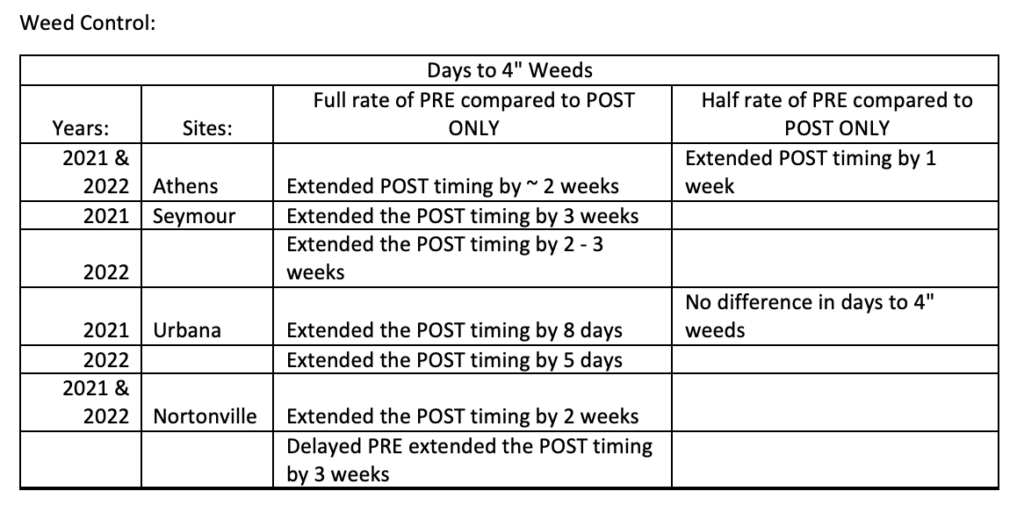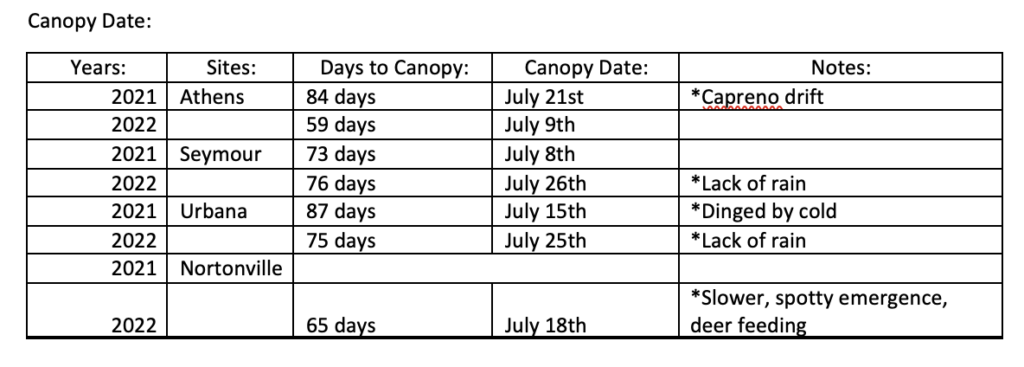by Aaron Hager, University of Illinois and Stephanie Porter, Illinois Soybean Association
In 2021 and 2022, Dr. Aaron Hager, University of Illinois, conducted research to establish a sound weed management program for very, early planted soybeans. Even though there has been extensive research done on weed control practices and solutions in soybeans, there has been a lack of data regarding impact of early-planted soybeans on weed control. The goal was to generate “proof of concept” so that Central Illinois as well as Midwest farmers know what recommendations should be given for managing weeds in soybeans when planted early.
In 2016, 0% of soybeans were planted by April 18th, but by 2021 increased to 5%; therefore, early planting in Central Illinois is being readily adapted and considered the first week of April. This can increase soybean yield by giving more days to accumulate growth prior to the summer solstice (Wilcox and Frankenberger, 1987), but also alter the timing of weed emergence relative to crop, which might call for an adjustment in chemical recommendations. Even though it’s highly environmentally dependent, residual herbicides may persist longer when applied to cooler soils, so a specific objective of this research was to evaluate various herbicides at different timings and rates to evaluate weed control and ultimately, soybean yield.
To execute this research, four locations were planted in Central Illinois to reduce the weather-related challenges. The application of soil-residual herbicides, soybean canopy closure date, weed emergence relative to soybeans, as well as overall weed densities were documented throughout the growing season. All trials were established after secondary tillage, with the exception of the Nortonville site (2021), which was no-tilled. XtendFlex soybeans were planted in 30-inch rows at a seeding rate of 144,000 seeds/acre. Herbicide treatments were applied with backpack sprayers equipped with the appropriate nozzles for PRE only, POST only, and PRE followed by POST herbicide treatments.


Weed Emergence:
- Overall weed emergence timings were similar among weed species each year, but the timing of weed emergence was slightly earlier in 2021 compared to 2022. This is important because earlier emerging weeds dictate and force an earlier POST herbicide application.
- Waterhemp and foxtail emerged after the POST application in treatments that did not receive Zidua SC, except at Athens in 2022. In 2021, Athens did have late season waterhemp emerge after the POST application, but none broke through the canopy.

- The PRE herbicide application timing at planting was the most consistent in providing solid control.
- Applying a full rate of PRE provided increased control, compared to a half rate or no PRE, at all locations during both years, except for Urbana.
- Delaying the PRE application offered no extended period of control, except for Nortonville.

Weed Density:
- Zidua SC did reduce late-season weed emergence.
- The full rate of PRE greatly reduced weed densities.
- The half rate of PRE was more inconsistent, but still provided control more often than in the absence of a PRE herbicide application.
Conclusions:
- A full rate of PRE plus POST herbicide application is the most reliable program.
- Reducing PRE rates offers variable weed control and is often insufficient.
- If you delay a PRE herbicide application, the further into the growing season it is applied, the greater chance weeds may emerge prior to the application.
- If you solely rely upon just a “PRE only” or “POST only” program, this allows weeds to compete with soybeans for a longer amount of time and either creates greater pressure on POST applications, possibly resulting in an increased amount of weed seed returning to the soil seedbank.
- Adding an in-season residual with the POST application reduces late-season weed emergence; however, there was no difference between half and full rate of Zidua SC
- The amount of early season emerging weeds (GDD < 150) remained low at all the trial locations, but they tended to be much larger than other summer annuals at the time of POST applications.
- A greater amount of pressure by giant ragweed and common lambsquarters may demand an earlier POST application.
- The full rate of PRE alleviates pressure on the POST application and allows for improved coverage of weeds.
- Two effective sites of action are crucial in the POST application, especially when controlling amaranth species.
- Early planted soybeans canopy at an enhanced rate compared to later planted soybeans; therefore, weeds that did emerge after the POST application failed to make it through the canopy.
- The POST application appears to be the last line of defense against weeds, but the ability of soybeans to canopy and smother out late flushes of weeds offers a late-season management strategy that can be fortified with an in-season residual.




 and then
and then